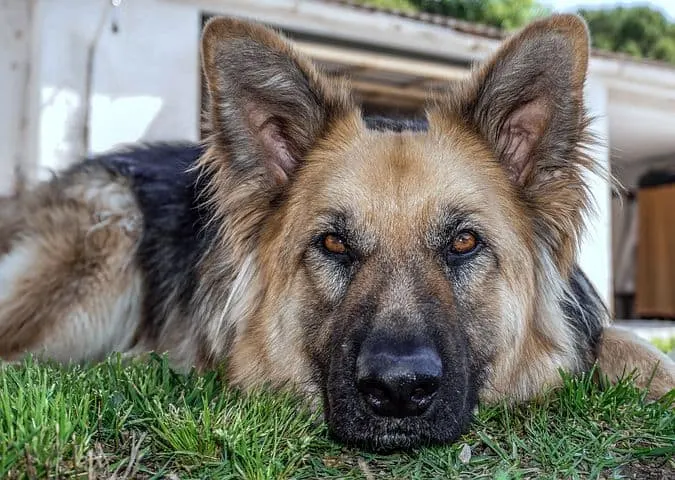What Is the Best Way to Clean A German Shepherd’s Unique Ears?
Do you need to know how to clean German Shepherd ears? How can you make cleaning your dog’s ears a routine part of her grooming ritual?
Do you approach cleaning your pet’s ears with a tentative swipe of a baby wipe?
After all, if you unintentionally hurt your dog, you could ruin her trust for life or, worse, injure an eardrum.
Cleaning your German Shepherd’s ears does not need to be challenging.
It is simpler armed with knowledge about the structure of your dog’s ears and what clues to look for that may indicate a problem.
Your technique then centers around whether you are performing a necessary cleaning with mild swabbing or a deep cleansing with a medicated solution.

How do you properly clean your German Shepherd’s ears?
While you probably will not perforate your dog’s eardrum from an ear cleaning, you can cause an ear infection utilizing improper techniques.
Eardrum damage is not unheard of if you forcefully jam cotton into the canal or utilize long Q tips.
What are dog ear-cleaning steps?
1. Prepare the environment – Secure your pet. You can clean your Shepherd’s ears directly in the tub.
Some do better on an elevated surface, such as a grooming table. Barring that, an area designated for special procedures should work well.
2. Collect your supplies – You need an appropriate ear-cleaning solution and cotton balls or cosmetic pads. Towels are helpful for head shaking.
3. Secure your dog – In many cases, a leash will get your Shepherd’s attention. Have him sit or lay down if it helps.
4. Grasp the middle part of your dog’s ear gently but firmly between your forefinger and thumb and lift slightly.
5. Fill the ear canal with an ear-cleaning solution. Gently massage the base of the ear. It is normal to hear the liquid squishing.
If using a medicated solution, make sure to leave the suspension in place for 5 to 10 minutes if possible.
6. Release your dog’s ear, allowing him to shake the excess liquid out.
7. Wipe any visible debris and excessive liquid from the inner ear flap and opening that you can see. Use a cotton ball as swabs are irritating, and tissue paper may fall apart.
8. If there still seems to be wax or debris build-up, repeat the rinse.
9. Do not use Q tips or anything else to penetrate the ear canal. Save these for the professionals as you can potentially drive wax and dirt deeper into the ear.
You can use little Q tips to gently swap the visible surfaces of your dog’s ears if mildly dirty.
10. If you observe any abnormalities such as discharge, swelling, redness, or signs of pain, schedule a visit with your pet’s veterinarian.
Slight waxy build-up and some dirt are normal if you regularly clean your dog’s ears.
This video is two-fold. It shows some tips on getting your dog used to having her ears cleaned.
Hopefully, your German Shepherd will not be so reluctant but notice the frequent petting, the slow progression through the steps, and the soothing voice.
You can also implement these methods when not cleaning the ears, touching the interior of your pet’s ears when petting him.
The video also shows a method to clean your dog’s ears when they need minimal attention or when your pet is protective of them.
Sometimes you will not be able to infuse your German Shepherd’s ears with a cleaning solution.
You can also enlist the help of a veterinarian, groomer, or even a trainer.
Apply any required medications or drops after an ear cleaning unless instructed otherwise. Some drops work better if ear wax or debris is present.
How often should you clean your German Shepherd’s ears?
You should always think about your Shepherd’s ears when you bathe or groom her.
If you wash your dog every two weeks, though, your dog’s ears do not need to be cleaned this often.
Nevertheless, you can take the opportunity to check for problems.
For German Shepherds with standard ears that have no issues with allergies or chronic inflammation, cleaning their ears every four to six weeks should suffice.
You can use a general ear cleaner for dogs, consulting your veterinarian with any questions.
According to AKC, The paradox is that excessive ear cleaning can promote infection because it may cause irritation, alter the inner ear pH, and disrupt healthy flora.
Also, using a solution not formulated for canines could be problematic. Your veterinarian can help you determine a suitable ear cleaning schedule for your dog.
How do you accustom your dog to cleaning his ears?
Get your dog used to having his ears handled at a young age. Most dogs enjoy having their ears petted, so take advantage of it.
While stroking the ears, talk soothingly and occasionally also rub the insides of the flaps.
Also, hold the pinnae from time to time and run your thumb across the exterior ear canal opening.
Reward cooperation with treats or a play break. When you groom or bathe your Shepherd, always touch her ears.
Even when not cleaning your Alsatian’s ears, train her that bath time means you will need to examine those appendages.

What solutions can you use to clean your dog’s ears?
A basic ear cleaning solution is best to use for most German Shepherds.
Consult with a medical professional before using alcohol or hydrogen peroxide in your dog’s ears.
Alcohol can be drying and irritating and downright painful if your dog has any invisible sores.
Despite its antibacterial properties, hydrogen peroxide is an irritant, especially if full-strength.
We recommend avoiding alcohol and hydrogen peroxide in your dog’s ears for general cleaning.
You can formulate home remedies with various apple cider vinegar solutions and essential oils such as tree tea oil.
It is ideal to consult with your veterinarian to obtain the correct concentrations and address safety concerns regarding how to clean German Shepherd ears.
A balanced pH is essential for inner ear health.
What should you know about your German Shepherd’s ear structure?
How does the pinna factor in?
According to the whole-dog-journal, a dog’s ears are made up of four parts, remarkably similar to people’s ears. The largest difference is the flap or pinna.
The pinna refers to the outer part of the ear you can see. It expresses the emotions of an animal and where his attention lies.
Nature has blessed German Shepherds with upright ear flaps with a wide opening.
A Shepherd’s ears are independently mobile and, more importantly, the exposed canal eliminates some of the issues you commonly see with floppy-eared dogs like Cocker Spaniels.
If your German Shepherd has classically erect ears, she will have excellent airflow across the exterior canal, facilitating dry conditions.
As you know, bacteria and yeast thrive in warm, moist environments.
Shepherd puppies are born with floppy or folded-over ears. You will see most of these pups’ ears come up by the time they are eight months old.
However, as many as 18 to 20% of German Shepherds have lazy or weak ears. One or both ears never fully stand up.
Many sources, including Pet Health Network, suggest these dogs may inherently have more ear infections than dogs whose ears do not lop.
What ear structures are beyond the pinnae?
Your dog has a long L-shaped external ear canal.
The first portion goes straight down as you look at your dog from above. It then makes a sharp angle as it progresses to the inner ear structures.
The horizontal part of your dog’s ear canal is what makes ear cleaning so important. You can help your dog expel debris and dislodge wax that builds up here.
The length and anatomy of your dog’s ear canal make it unlikely you will hit the eardrum while cleaning. You need to exercise care in your choice of cleaning solutions, though.
A thin barrier, the eardrum or tympanic membrane, lives between the external ear canal and the middle ear. It amplifies incoming noise vibrations.
A middle ear infection often indicates a tear or hole in the eardrum.
Sound progresses from the middle ear inward via three tiny bones, the stapes, incus, and anvil.
The inner ear is responsible for balance and hearing via the vestibular fluid and cochlea, respectively.
Middle ear infections can progress to the inner ear.
Ear infections that affect the external, middle, and inner ear are damaging, but other issues can also impair your pet’s auditory health.

What problems can affect your German Shepherd’s ears?
There are a few categories of ear problems in dogs.
Infections are what we think of most commonly, but nervous system disorders, vestibular disease, cancer, and parasites must be ruled out.
For example, tumors can grow in the middle ear.
According to a few veterinarian sources and the AKC, 75 to 80% of dogs with food sensitivities and up to 50% with contact hypersensitivity will manifest their allergies with ear problems.
What are the most common causes of canine ear infections?
Allergies
German Shepherds are not typically allergic dogs, but they can have food and environmental sensitivities.
White Shepherds seem more susceptible to immune problems, allergies, and similar ear problems.
Ear mites
These are tiny parasites most common in puppies and dogs living around infested cats. Your veterinarian can easily diagnose them with a microscopic examination of an ear debris smear.
Yeast
According to Hemopet, Malassezia pachydermatitis and Candida are two common yeasts that naturally inhabit the skin and ears of dogs.
Your Shepherd will exhibit symptoms of infection if these organisms become overgrown as in allergies or other immune-compromising disorders.
Bacteria
Different types of disease-causing, or pathogenic, bacteria can cause ear infections.
Often classified according to whether they take up Gram stain or not, diagnosis with an ear culture is necessary for resistant cases.
The ear is similar to the skin and gut in that it has a population of healthy bacteria.
When these organisms become disrupted, it paves the way for pathogenic fungi, yeast, or bacteria to move in.
We did not mention hair because it does not affect most GSDs. Poodles and other breeds may have hair that grows far down in the outer ear canal.
Groomers pluck this hair during haircuts. If you have a long-haired German Shepherd, you may need to trim the hair around each ear’s opening.
According to Veterinary Partner Vin, gram-negative bacteria like Pseudomonas are particularly tricky to treat, becoming increasingly so without proper diagnosis and medication.
Diagnosing ear infections includes an otoscopic exam, an examination of ear debris under a microscope, allergy tests, cultures to identify bacterial species, and bloodwork to rule out underlying diseases.

What are signs that your Shepherd has an ear problem?
Dogs’ ears are extremely sensitive, and it is unlikely your German Shepherd will be able to hide her discomfort. Signs of ear problems may even appear dramatic to you.
According to WebMD, there are several classic symptoms of an ear infection.
- Head shaking
- Head tilt
- Redness in the external ear canal and inside the pinnae
- Scratching the ears or pawing the top of the head
- Patchy hair loss or matted hair behind the ears – This is usually a sign that your dog has been scratching. Some Shepherds have long tufts of hair around the ears that are subject to matting.
- Foul odor to the ears – Both bacteria and yeast have a distinctive smell.
- Your dog suddenly will not allow you to clean his ears – Blame the pain.
- Any discharge is abnormal – Discharge can be brown, black, white, yellow or blood-tinged
- Nystagmus – This is an abnormal movement of the eyes whereby they appear to be swimming from side to side or twitching up and down. Such patterns can also indicate vestibular disease or a problem located in the brain.
- Swelling – Inflammation, and infection can manifest as swelling. Another phenomenon, more commonly observed in floppy-eared dogs, is a hematoma. A blood-filled pocket will occasionally form between the two layers of skin in the ear flap from excessive shaking of the head.
Proper Cleaning Supports Strong Ear Cartilage
Hopefully by this point in the article, you are aware of the benefits that regular ear cleaning provides for your GSD.
But there is actually a lesser known bonus from proper ear cleaning:
Lowering the chances of your German Shepherd breaking their ear cartilage.
Especially as puppies when their ears are not fully developed, GSDs are at a higher risk of damaging their ears.
This can happen during rowdy play with other dogs, from excessive scratching, and from ear infections.
As a result, German Shepherds can end up having floppy ears, as opposed to the classic fully erect ears.
But keep in mind that improper ear cleaning can also damage the cartilage and other parts of German Shepherds’ ears.
This makes it all the more important to do your research before cleaning this sensitive part of their body.




















